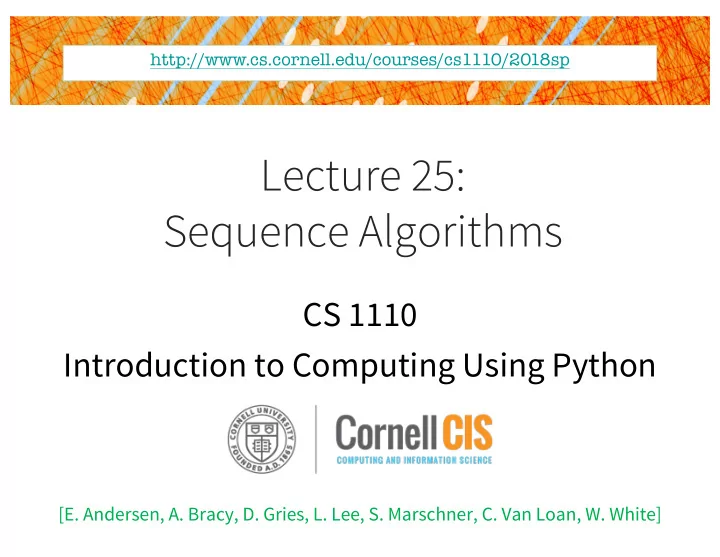

http://www.cs.cornell.edu/courses/cs1110/2018sp Lecture 25: Sequence Algorithms CS 1110 Introduction to Computing Using Python [E. Andersen, A. Bracy, D. Gries, L. Lee, S. Marschner, C. Van Loan, W. White]
Announcements • Prelim 2 is graded • A5 is out! § Clarification on webpage about what happens when the deck has too few cards in it • Final Lab is this week: § Reminder: labs cannot be checked off during Wed consulting hours the week after they are released • Final Exam: § May 17 th , 9am-11:30am § Location : Barton Hall Central and East 2
Box Notation for Sequences 0 k len(b) sequence b <= sorted >= Graphical assertion about sequence b. It asserts that: 1. b[0..k–1] is sorted (values are in ascending order) 2. all of b[0..k–1] is ≤ all of b[k..len(b)–1] Pro Tip #1: index always goes above a box , never above a line (just like house numbers go on a house not between the houses) x 0 k len(b) 0 k len(b) 0 k n 3
Q: Indices for Box Notation 0 h k sequence b Given: index h of the first element of a segment • index k of the element that follows that segment, • A: 0 Questions: B: 1 How many values are in segment b[h .. k – 1] 1. C: 2 How many values are in b[h .. h – 1] ? 2. D: k - h How many values are in b[h .. h + 1] ? 3. E: k + h Pro Tip #2: Size is “Follower minus First” Follower: next thing outside the specified range 4
A: Indices for Box Notation 0 h k sequence b Given: index h of the first element of a segment • index k of the element that follows that segment, • A: 0 Questions: B: 1 D How many values are in segment b[h .. k – 1] 1. C: 2 A How many values are in b[h .. h – 1] ? 2. D: k - h C How many values are in b[h .. h + 1] ? 3. E: k + h 5
count num adjacent equal pairs (1) Approach #1: compare s[k] to the character in front of it (s[k-1]) # set n_pair to # adjacent equal pairs in s n_pair = 0 k = 1 while k < len(s): if s[k-1] == s[k]: n_pair += 1 k = k + 1 6
count num adjacent equal pairs (2) Approach #1: compare s[k] to the character in front of it (s[k-1]) # set n_pair to # adjacent equal pairs in s 0 n pre: seq s ? (unknown values) n >= 0, n_pair = 0 n_pair = 0 k = 1 0 k n n_pair = num adjacent INV: seq s processed ?(unknown) pairs in s[0..k-1] while k < len(s): if s[k-1] == s[k]: n_pair += 1 k = k + 1 0 n processed post: seq s n_pair = num adjacent 7 pairs in s[0..n-1]
find the max of a seq (1) Task: find the maximum of a sequence s k = 1 big = s[0] while k < len(s): big = max(big, s[k]) k = k + 1 8
find the max of a seq (2) Task: find the maximum of a sequence s big is the max of this segment (s[0]) 0 n ? (unknown values) n > 0, big = s[0] pre: s k = 1 big = s[0] 0 k n inv: s big is max of this segment ? n > 0, big = s[0..k-1] while k < len(s): big = max(big, s[k]) k = k + 1 0 n post: s big is the max of this segment k = n, big = max of s[0..n-1] 9
Developing Algorithms on Sequences • Specify the algorithm by giving its precondition and postcondition as pictures. • Draw the invariant by drawing another picture that “moves from” the precondition to the postcondition § The invariant is true at the beginning and at the end • The four loop design questions 1. How does loop start (how to make the invariant true)? 2. How does it stop (is the postcondition true)? 3. How does the body make progress toward termination? 4. How does the body keep the invariant true? 10
Task: separate + from – in a list Task: Put negative values before nonnegative ones and return the split index k = 3 5 -7 2 2 -1 8 -3 9 3 -7 -1 -3 2 5 8 2 9 3 11
Invariants: separate + from – in a list Task: Put negative values before nonnegative ones and return the split index k = 3 5 -7 2 2 -1 8 -3 9 3 -7 -1 -3 2 5 8 2 9 3 0 n pre: s ? (unknown) n >= 1 k = 0 j = n s[0..k-1] negative 0 k à ß j n s[j..n-1] zero or + inv: s ? < 0 >= 0 s[k..j-1] unknown while k < j: <body goes here> 0 k n 12 post: s k = j < 0 >= 0
Body: separate + from – in a list k = 0 j = n s[0..k-1] negative 0 k à ß j n s[j..n-1] zero or + inv: s ? < 0 >= 0 s[k..j-1] unknown while k < j: if s[k] < 0: # kth elem stays where it is k = k + 1 elif s[j-1] >= 0: # (j-1)th elem stays where it is j = j - 1 else: # both elements in the wrong place swap(s, k, j-1) k = k + 1 j = j - 1 0 k n 13 post: s k = j < 0 >= 0
Recommend
More recommend